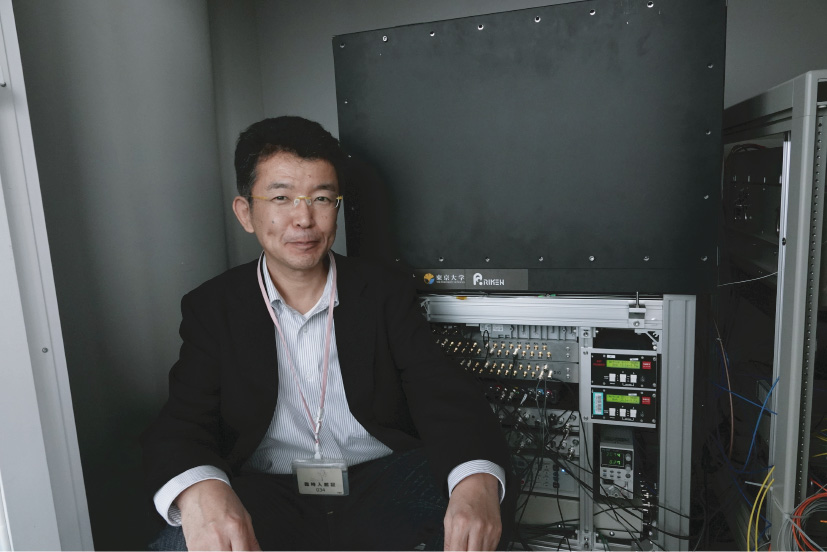Of all the units of physical science, one second is perhaps the most mysterious. Unlike a meter, we cannot see it. Unlike a kilogram, we cannot hold it in our hands. Unlike a volt, we have no nerves to sense it.
Yet a second is the most precisely quantified unit we have [1]. This year, metrologists—scientists who study measurement— announced the first transportable clock that can measure time to 18 decimal places. To put this in perspective, a clock running with this precision since the Big Bang would have lost or gained less than half a second.
In the April 2020 issue of Nature Photonics, Hidetoshi Katori, a professor of applied physics at the University of Tokyo, together with six colleagues described how they used the clock to test Albert Einstein’s prediction of time dilation with the greatest precision ever for a ground-based clock [2]. Einstein’s prediction passed the test. More importantly, the Katori-led team’s design for a more precise clock passed the test of transportability. Such clocks could become the standard for the next generation of atomic clocks [3], and the ability to move them greatly enhances their practicality.
Since 1967, scientists have used a definition of a second that relies upon quantum physics.When excited by a laser, cesium atoms emit light waves with a frequency of 9 192 631 770 Hz [3,4]. This is not a measurement but a definition, one that has enshrined cesium clocks as the arbiter of the time calibrations that are foundational to much of the digital technology the world increasingly has come to rely upon. But as good and effective as they are, current stateof-the-art cesium clocks can measure time only up to 16 decimal places of accuracy, primarily because fractions of a cycle are difficult to measure.
In the early 2000s, Katori began working on a more precise clock technology, called an optical lattice clock. The clocks use strontium atoms that emit visible light, rather than microwave radiation, which is why they are called optical. Their advantage is that the visible light has a much higher frequency: 429 288 004 229 873.0 Hz [1]. Note that this number has 16 digits; the measurement is limited by the accuracy of the cesium clock that defines the length of the second. With strontium clocks we could gain two more decimal places of accuracy. Some of the improvement comes from the fact that the clock can interrogate thousands of strontium atoms at once, which are trapped in a lattice, i.e., an optical lattice. For statistical reasons, N measurements reduce the error by a factor of  p , provided that the source of error is random noise. Even though this is only a modest improvement in precision, precision is everything in metrology.
p , provided that the source of error is random noise. Even though this is only a modest improvement in precision, precision is everything in metrology.
Throughout the 1990s, the most promising next-generation clock technology had been single-ion clocks, in which electric fields hold a single charged atom in place, a technique invented by Nobel Prize laureates Hans Dehmelt and Wolfgang Paul [5,6]. Single-ion clocks have several advantages. "The ion is well located, and this good location means you get no Doppler effect,” said Christian Lisdat, head of the Optical Lattice Working Group at the Physikalisch-Technische Bundesanstaldt, the German National Metrology Institute, in Braunschweig. "That’s the big enemy in optics, because the Doppler effect gives you the wrong frequency.”
However, Katori deliberately chose to work on an unproven technology. He compared his team’s research in Japan to Charles Darwin’s research in the Galapagos Islands, far from the mainstream of science. "It was an ideal situation for us to concentrate on our new endeavor without being bewildered by other people’s work,” Katori said. "Our ‘Galapagos Islands’ isolation allowed atomic clocks to evolve in a different way from the rest of the world.”
In an optical lattice clock, the strontium atoms are captured and held in place by laser light. However, it is a very delicate operation. "When the laser interacts with the atom, it produces a dimple in space where the atom wants to sit,” said Lisdat. But the dimple is extremely shallow, which means that the atoms must be cooled to a few thousandths of a kelvin. But there is an even greater challenge. Creating a dimple in the energy landscape alters the energy levels of the electrons inside the strontium atom. In other words, the very act of holding the atoms in place changes the size of the quantum leap you are trying to measure.
But Katori and colleagues found an ingenious solution. The frequency of the emitted light is determined by the difference between two energy levels within the strontium atom. By carefully tuning the frequency of laser light that creates the "dimples,” Katori changed both of these energy levels by the same amount. That causes the two discrepancies to cancel. "It’s called the ‘magic wavelength’ for obvious reasons,” said Lisdat. "You get a trap but you do not get a change in the frequency.”
First demonstrated in 2003, the optical lattice clock technology is now just as advanced as that of single-ion clocks. "There are nearly 20 groups developing strontium clocks worldwide,” Katori said. "The participation of a large number of groups is an important driving force to push re-definition of the second.”
However, the 18-digit precision will be wasted if you can only synchronize the clocks to 16-digit precision. That is the current limit of satellite technology, because they use cesium clocks to tell time. Fiber-optic technology is better, but it can only work over medium distances. Clocks in Europe can be synchronized with each other but not with clocks in America.
Enter Katori’s latest invention: a transportable strontium clock. All previous optical lattice clocks have been room-sized instruments, requiring bulky laser and cooling equipment. In his most recent work, Katori shrank the whole package down into three boxes with a total volume of roughly one cubic meter (Fig. 1) [2]. To make them resistant to the vibrations they would encounter outside the laboratory, his team welded the lasers in place and eliminated all adjustment knobs; the instrument is controlled through the Internet. An especially innovative idea was the use of a thermally shielded ‘‘interrogation chamber” to insulate the trapped strontium atoms from blackbody radiation generated by the surrounding environment. The atoms are first trapped in an optical lattice outside of the shielded chamber by two lasers at the ‘‘magic frequency,” then they are gradually moved into the chamber by detuning one of the lasers slightly. It is like sliding a patient into a computerized axial tomography (CAT) scanner. ‘‘This is an absolutely fascinating technical achievement,” said Professor Kai Bongs, principal investigator at the UK Quantum Technology Hub Sensors and Timing and director of Innovation at the College of Engineering and Physical Sciences at the University of Birmingham in England.
《Fig. 1》

Fig. 1. Professor Hidetoshi Katori kneels next to one of the two transportable optical lattice atomic clocks—this one at the top of Tokyo’s Skytree tower (see Fig. 2), the other at the bottom—which used the clocks’ ability to measure the second to 18 decimal places in an experiment testing Albert Einstein’s prediction of time dilation with the greatest precision ever for a ground-based clock [2]. Each of the transportable clocks, built by Katori and colleagues at the University of Tokyo, consists of three boxes with a total volume of roughly one cubic meter. Credit: Courtesy of Hidetoshi Katori.
Katori’s group took one of the clocks up to the top of Tokyo’s 450 m high Skytree tower (Fig. 2) [2] while leaving the other one at the base. In these un-controlled, non-laboratory conditions, he measured the difference between one second at the top of the tower and one second at the bottom. Einstein’s theory of relativity predicts that the strontium light should have a frequency 21.18 Hz less at the bottom of the tower than at the top, due to an effect called time dilation, which assumes time passes more slowly the closer you are to the center of the earth. Thanks to their 18-decimal precision, and their rugged design, that was exactly what Katori’s clocks measured.
《Fig. 2》

Fig. 2. Professor Hidetoshi Katori and colleagues successfully tested the precision of their transportable strontium-based atomic clocks by placing one clock at the top of Tokyo’s 450 m tall Skytree tower and another at the bottom [2]. Credit: Wikimedia Commons (CC BY-SA 4.0).
If the cost and transportability can be improved enough, one can imagine putting a strontium clock aboard every Global Positioning System (GPS) satellite, replacing their cesium clocks. That is not likely to happen soon. However, if that happens, clocks of GPS satellites could be synchronized with 18-decimal accuracy, opening up many new applications. Until then, it will be possible to synchronize clocks on the ground by the simple, old-fashioned expedient of taking them to different places.
The new clocks have other potential applications. Think, for example, of the rising of sea levels or the expansion of a volcano getting ready to erupt. "Height measurement with centimeter precision over long distances, such as 100 km, or in short time periods of less than hours, has been impossible with existing technologies,” Katori said. With the new clocks scientists could measure differences in height by detecting time dilation, an approach called chronometric geodesy. "It is one of my favorite applications,” said Lisdat. "Many people ask me what is the interest of 10-18 s accuracy. Having reliable information about what we’re doing to planet Earth makes it worthwhile.”













 京公网安备 11010502051620号
京公网安备 11010502051620号




